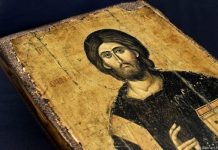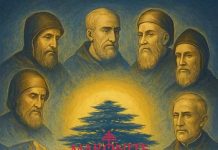Christians Burned Alive for Refusing Islam
By Raymond Ibrahim/
February 11, 2015
As the world reacts with shock and horror at the recent immolation of a Jordanian pilot at the hands of the Islamic State, it is well to remember that this particular form of savagery has a long history in Islam and under the state.
The image to right is of Sidhom Bishay, a Coptic Christian who was immolated in 1844 by local authorities for reportedly “insulting Muhammad,” the prophet of Islam. Today deemed a saint for his martyrdom — he was tortured and eventually immolated with burning tar for refusing to renounce Christ and convert to Islam — his face and body appear frozen in the same position he died in (he turned his head away from the side first hit with tar, and his raised shoulders are from the shock of having tar poured on).
Sometime in March 1844, Bishay was on his way to church in the Damietta cemetery when a Muslim donkey-driver ran into him and started scolding the Copt, eventually escalating into an argument. As crowds gathered around, the Muslim driver falsely accused the Christian of insulting Muhammad in order to “get even” (see pgs. 135-145 of Crucified Again to see how this sort of “retribution” –falsely accusing Christians of “blasphemy” in order to get “even” with them — is still a common practice today, especially in Pakistan).
Further incited by a local imam, the enraged mob beat and kicked Bishay and dragged him along the street until his face was a bloody pulp.
A few days later, they brought him before Khalil Agha, the governor of the city. In the presence of the judge, Bishay was asked to abjure Christianity and embrace Islam under pain of death. He refused and was condemned to receive 500 lashes followed by execution. In front of the governor, Bishay was beaten with shoes and dragged across a staircase until his facial bones were crushed.
All the while the mob was shouting ” Kill him! Burn him!” According to a 19th century manuscript referring to the incident, that martyr for Christ went through many tribulations.
On the fourth day, his persecutors returned and stripped him naked, mocked him, and paraded him through the streets of town dressed in a sheepskin. They covered his body with mud and his head with a dirty cloth. Then they fastened meat cuts with iron clips around his hips and tied two hungry dogs and a cat to let them fight each other and bite at his flesh. After that, they made him ride a buffalo upside. The crowd cheered as he crossed town as when an animal is led to slaughter.
The man “never lost his patience but kept invoking the Virgin and Christ,” say the chroniclers.
Finally, boiling tar was poured all over his head and face and he was left outside the door of his home. His family attempted to nurse him, but he died five days later on (March 25, 1844. During these five days, members of Damietta’s Christian community locked themselves in their homes for fear of attacks by the enraged mobs.
Sidhom Bishay was subsequently canonized by the Coptic Orthodox Church. His body rests today in a glass-fronted shrine in the Cathedral of Saint Mary in Damietta — a reminder that burning “infidels” alive is not something new in the Islamic world.





















